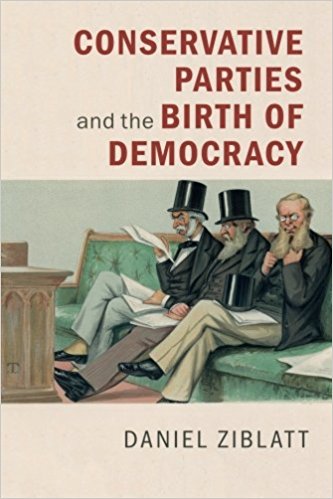
 From the Polish Law and Justice party’s electoral victory of 2015, and the growing importance of Alternative für Deutschland in Germany to the late British and Austrian elections, a wind of conservatism is blowing upon European countries. While many fear a possible retreat of democracy following these reactionary surges, Daniel Ziblatt’s Conservative Parties and the Birth of Democracy demonstrates that strong and well-organized conservative parties paradoxically played a crucial role in the democratization and constitutional stability of European countries from the nineteenth century to the Second World War.
From the Polish Law and Justice party’s electoral victory of 2015, and the growing importance of Alternative für Deutschland in Germany to the late British and Austrian elections, a wind of conservatism is blowing upon European countries. While many fear a possible retreat of democracy following these reactionary surges, Daniel Ziblatt’s Conservative Parties and the Birth of Democracy demonstrates that strong and well-organized conservative parties paradoxically played a crucial role in the democratization and constitutional stability of European countries from the nineteenth century to the Second World War.
In his introductory chapter, Ziblatt starts with presenting two paths of democratization in Europe during that period: settled and unsettled democratic transition and consolidation. The first path is epitomized by the case of Great Britain (but is common to other countries like Sweden or Denmark), and is described as a path in which democracy was progressively constructed following a relatively direct path, without major democratic backsliding, coups or authoritarian moments. Whereas, in a process of unsettled democratization, “democratic development was stalled for longer period in time (…), and once initiated, often subject to more severe antidemocratic threats an actual coups” (10). He illustrates this second pattern of democratisation with the case of Germany from the late nineteenth century to the fall of the Weimar Republic.
According to Ziblatt, the main reason explaining these two patterns of democratic development from the nineteenth century to the Second World War is not the differences in living standards between countries or the particular political strength of the working and middle class in some regimes. It is, rather, the constitution of well organized conservative parties by the old regime’s elites that is the key factor for such a divergence between continental constitutional histories. For him, “Democracy’s long run stability hinged not on whether power could be taken away from elites but rather on just how elites themselves were able to organizationally change and survive” (22). Indeed, through conservative parties, old regime incumbents could maintain their political dominance by playing according to the rules of the democratic game. Thanks to the organizational strength of their party, conservatives could enter into the electoral contest and try to win the votes of the middle class, while conservative leaders could rein in the diehards of the party.
Chapter 2 develops his theory of conservative parties’ formation and determines the role of these parties in the process of democratization, a theory which structures his analysis of Great Britain and Germany in the next chapters. He defines conservative parties as political formations with a central constituency at their founding of upper-class propertied economic or political elites, generally sharing anti-secularism, political inegalitarianism, economic protectionism alongside with a defence of landed elite, clerical or monarchical authorities. After 1848, these parties faced a dilemma: to gain power they should adapt their electoral strategies to convince a vast number of voters, accepting political compromises that might impinge on their very conservative beliefs and interests. The ways in which British and German conservative parties dealt with this dilemma reveal how party organization explains the settled and unsettled paths towards democracy from 1848 to the Second World War.
Chapters 3 to 5 analyse the emergence of a strong conservative party in Great Britain and show the decisive role played by the Tory party’s very structured organisation in its electoral successes of the late nineteenth century and its resilience to electoral crisis. He explains how this party, after the second half of the nineteenth century, transformed itself from an impressively strong parliamentary formation but lacking rank-and-file organization (a description that fits with many other conservative parties of this century) into a party fully equipped to play electoral politics (65). Thanks to their ties with popular organizations (especially the Primrose League) and the presence of experts of the party, Tory leaders could hope to win the elections and were less incited to resort to electoral rigging. Engaging in the electoral contest became a game worth playing for British conservatives, thanks to the Tory party’s robust political organization and capacity to attract voters of the middle class by appealing to their nationalist and religious beliefs.
Consequently, the Tory party reorganisation of the second half of the nineteenth century appears to be a precondition for the democratic transition and consolidation in Great Britain (171). This last point draw attention to Ziblatt’s conclusion that British democratization was not already settled after the Glorious Revolution of 1688. As he concludes against the Whig interpretation of Britain’s political development: “path-dependence is not predetermination,” a point he exemplifies with the German case from 1848 to the fall of the Weimar Republic.
Chapters 6 to 9 explore the structuration of the German conservative party and the role of its organizational flaws in the German institutional and constitutional instability at that time. In these four chapters, Ziblatt shows how the Deutschkonservative Partei (DKP), while willing to organize itself in a strong party like the Tory party, failed to do so. To survive electoral competition, the nineteenth -century DKP mostly relied on State interventions in elections and collusive bargains with other political formations. This brought a poorly organised German conservative party at the local level to seek the support of already strong civil society associations and interest groups. Eventually, these groups like the Agrarian League took over the party organization. Unlike the Primrose League in the United Kingdom, which was shaped by the Tory party to fit in with its political ends, the Agrarian League transformed the German conservative party into a more anti-Semitic, militarist and protectionist party. This moved the party on the right side of the very monarchy it was initially supposed to defend. In chapters 8 to 9, Ziblatt focuses his analysis on the aftermath of the structuration of a weak German right during the Weimar Republic. He argues that the Weimar Republic demise was not due to the weakness of its pro-democratic coalition but rather a consequence of the right parties’ political factionalism inherited from the organizational flaws of the former conservative party.
Conservative Parties and the Birth of Democracy brilliantly demonstrates that it was to some extent according to the strength and degree of organisation of conservative parties that the liberal democracies of the continent thrived or failed before the Second World War. Ziblatt pays particular attention to all hypotheses to explain his cases and supports his arguments with a great variety of sources from statistical data to archives. His work goes beyond classical explanations on the way in which democracy became self-enforcing at the beginning of the twentieth century. Party organisation and its links with less formal groups (social clubs or interest groups) channelled “the counter pressures to regime change in ways that reinforce democratization rather than undermine it” (367).
This study has, however, some limitations mainly stemming from the selection of the cases studied. Chapter 10, which broadens the comparison to other cases like Sweden, Spain and France, reveals these limits, especially with regard to socioeconomic, religious factors and the influence of unitary or federal structure of a country on the construction of its political parties. Firstly, in this book, Ziblatt concludes that the level of socioeconomic development of the societies studied comes short to explaining their democratic transition and consolidation. But one might argue that this conclusion is the result of the choice of the cases studied. Indeed, by focusing his comparison on two industrialized and wealthy nations at the end of the nineteenth century (Great-Britain and Germany), the comparison lessens the importance of such explanative variables. This conclusion is, however, less convincing regarding the relatively low socioeconomic development of Spain, Italy or even France at that period.
Moreover, Ziblatt analysis paid a superficial attention to religious differences in his analysis. If, in the predominantly Protestant Germany and Great-Britain at the end of the nineteenth century, this variable does not appear as important, it is harder to discard religion while his theory is applied to other European countries. Before the Second Vatican council and the Catholic waves of democratization that followed (Huntington 83–84), Catholic groups or regions were often opposed to the democratization process in the nineteenth-century Europe. On that respect, the Swiss case of the Sonderbund War of 1847 illustrates this point well. On one side the liberal-radical Protestant cantons wanted to establish a strong representative federal State, while Catholic conservative cantons resisted it by taking up arms against the federal reformist power (Tilly 172-6). In the end, the Catholic cantons were defeated and a new federal constitution on which was founded the contemporary Confederation was adopted in 1848.
Finally, Ziblatt does not take into account the difference between unitary and federal systems in his analysis, while the choice of his two main cases suggests the possibility of such a correlation. Indeed, with the case of Great-Britain, he explores the emergence of a strong Tory party at the end of the nineteenth century in a unitary state, whereas with the German case he analyses the structuration of a weak conservative party in a federal country. Ziblatt mentions, however, briefly the influence of federalism in chapter 10 – for instance, on particular features of Argentinian politics at the beginning of the twentieth-century – but he does not unfortunately develop this point further (Ziblatt 359).
Yet, the great variety of the evidences provided (archives, extensive secondary literature, statistical analysis), the erudition of his work and his thorough discussions of his hypothesis and alternative explanations largely offset these minor flaws. Conservative Parties and the Birth of Democracy is definitely an important contribution to our understanding of democratic development and authoritarianism in Europe from the nineteenth century to the Second World War. According to his historical analysis, it seems that it is not conservative resurgences that liberal democracies should worry about but the lack of organization of some reactionary parties, which eventually lead them to use antidemocratic means to take power and impose their views.
Reviewed by Henri-Pierre Mottironi, University of Lausanne, Switzerland
Conservative Parties and the Birth of Democracy
By Daniel Ziblatt
Publisher: Cambridge University Press
Hardcover / 427 pages / 2017
ISBN: 9781139030335
References
Huntington, Samuel P., The third wave: democratization in the late twentieth century, 1. paperback print., Norman, Univ. of Oklahoma Press, The Julian J. Rothbaum distinguished lecture series, n˚ 4, 1993, 366 p.
Tilly, Charles, Contention and democracy in Europe, 1650 – 2000, Cambridge, Cambridge Univ. Press, Cambridge studies in contentious politics, 2004, 305 p.
Ziblatt, Daniel, Conservative Parties and the Birth of Democracy, New York, NY, Cambridge University Press, Cambridge studies in comparative politics, 2017, 427 p.
Published on February 1, 2018.




